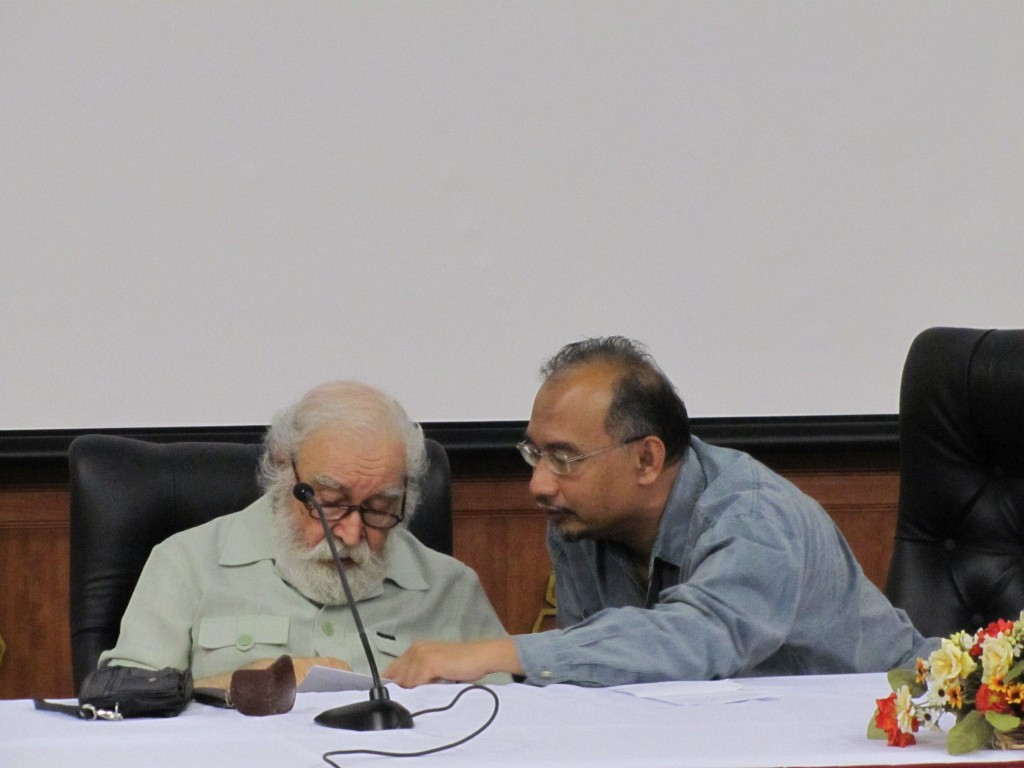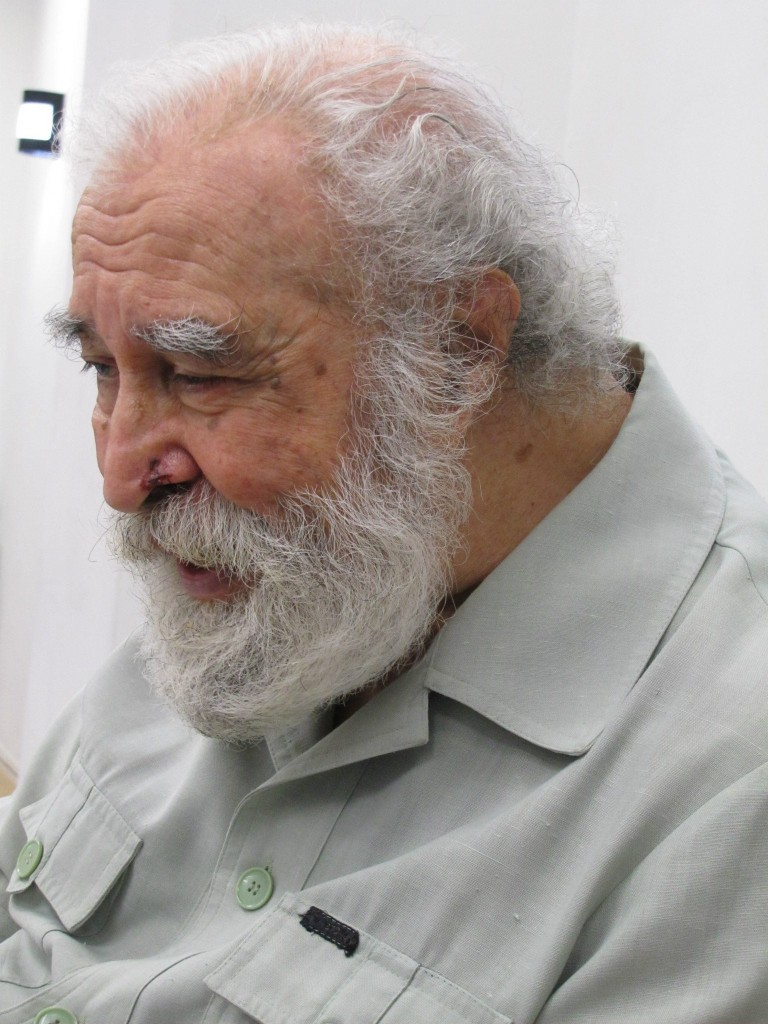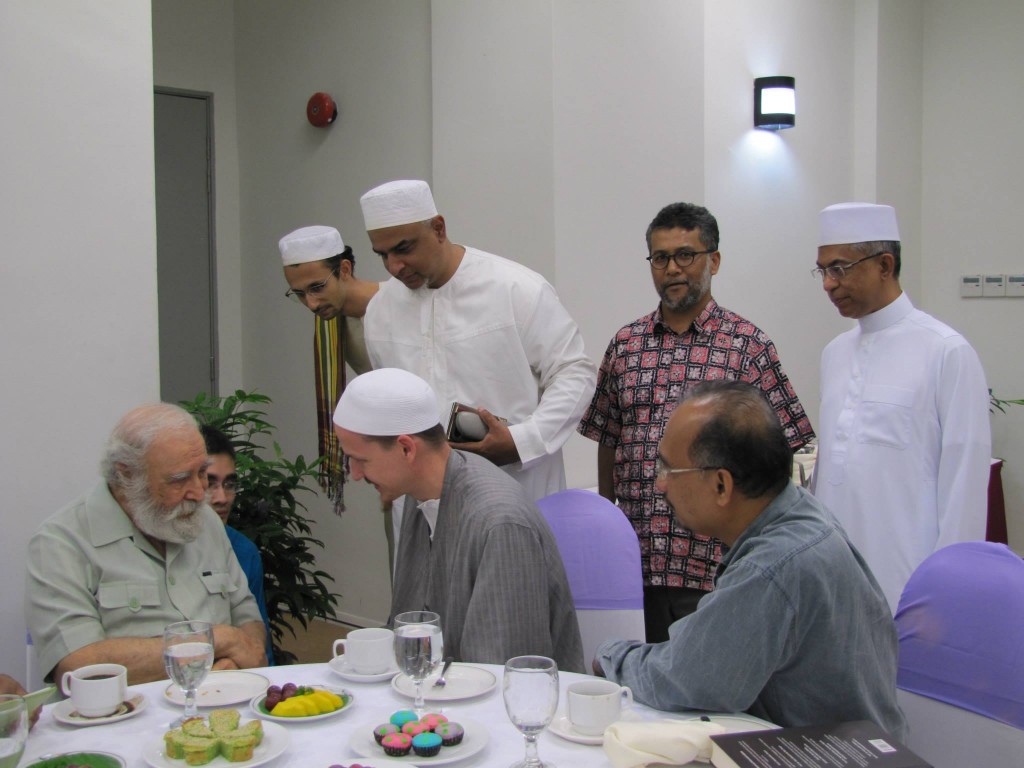Summary of Saturday Night Lecture 3rd Series with SMN Al-Attas
“The Malay Language and its role in nation building”
14th September 2013
The 14th of September 2013 marked the return of the long-awaited Saturday Night Lecture Series of YM Tan Sri Prof. Syed Muhammad Naquib al-Attas organized at CASIS UTM for the year of 2013. In conjunction with Malaysia Day which would fall 2 days later on the 16th of September in remembrance of the establishment of the Federation of Malaysia, Prof. al-Attas delivered a lecture on the Malay Language as the foundation for the nationhood of Malaysia.
Prof. al-Attas shared with the students and audience of his personal story on his role and involvement in laying down the foundations of the Malay Language as the National Language, having spent his youth days being brought up in the household of his uncle Dato’ Onn Bin Dato’ Jaafar who was the leading nationalist figure at that time and also founder and first president of the United Malay National Organization (UMNO)1. It was in the year 1957 (possibly after resigning from his Commission to serve as an officer and fighting against Communist terrorists in the Malayan jungles and in the midst of studying as an undergraduate at the University of Malaya) that he gave four hour radio2 talks on the concept of nation and nationhood, elaborating on what constitutes the Malaysian nation. Questions like who is the Malaysian and what is nationality needed clarification, because a nation cannot be built by forcing people together and hoping that people would naturally and gradually form a nation. Malaysian society was unlike the Arabs who possessed natural solidarity3; plans must be put in place to develop solidarity. Prof al-Attas cited the analogy of a stone that needs sculpturing before it can be turned into a statue; if the stone is left alone to the forces of nature, it would never form a statue.

Prof al-Attas then proceeded to elaborate on the meaning of nation, stating that a nation is formed by sentiment of solidarity that can only be developed within people through one of these elements: common race, common religion, common political and historical destiny and common language. In the context of a multi cultural and multi religious society like Malaysia, the only way forward to create this sentiment of solidarity was to promote a common language, the Malay Language as a national language. Furthermore, promoting a common language among the people was something that can be established by law; we cannot force others to accept our religion.
It is with this in mind that Prof. al-Attas rejected the idea of multi lingualism propagated by the then leader of the Opposition in 1964, Mr Lee Kuan Yew4 (who coincidentally celebrated his 90th birthday 2 days later from the date of this lecture as well). Lee Kuan Yew argued for multi lingualism as opposed to a common national language, using the success story of Switzerland5. Additionally, Mr Lee claimed that the Malay Language was not suitable to be selected as the national language because it was inferior to the Chinese Language and its millennia-long cultural and philosophical history.
In responding towards the first argument, Prof al-Attas highlighted the false analogy of comparing Malaysia to Switzerland, because the different communities in Switzerland already share the same religion. Besides, they also share the same ancestry and stock. This stands in stark contrast to the multi religious and multi cultural society of Malaysia. As for the second argument, Prof al-Attas highlighted the fact that the Chinese Language as practised in Malaysia is not Mandarin. Rather they were Chinese dialects such as Hokkien, Cantonese and Teochew used by labourers rather than scholars or philosophers of mainland China. Therefore, the claim of superiority in this case is made irrelevant.
This battle to uphold the Malay Language as the national language raged on in 1968 when Prof al-Attas, as a member of the GERAKAN, engaged in a debate with Lim Kit Siang and the Opposition from the Democratic Action Party (DAP)6 on the subject matter of Indonesian literature being made as part of the corpus of Malay Language literature, and on the idea of a Malaysian Malaysia. Responding towards Lim Kit Siang’s claim that making the Malay Language the national language is racist and chauvinistic, Prof. al-Attas argued that Malays cannot be accused as racist because a Chinese who becomes a Muslim and speaks the Malay Language can be considered a Malay. A Malay, however, can never be a Chinese.
It was perhaps as an intellectual response to this debate that the paper “Konsep Baru Mengenai Rencana serta Cara-gaya Penelitian ilmiah Pengkajian Bahasa, Kesusastraan, dan Kebudayaan Melayu”7 was written by him and subsequently published in 1972 by National University of Malaysia. In this paper that Prof. Al-Attas laid bare the intentions of Stamford Raffles and other Orientalist linguists and historians. Quoting from the Hikayat Abdullah, Raffles was documented asking Abdullah Munsyi for the reason behind the teaching of the Qur’an first before the Malay Language, before declaring his ambition of setting a new institute for the teaching of the Malay Language, because “the Malay Language has far better use (as compared to the teaching of the Qur’an)”8. This ambition was not realised during Raffles’ lifetime, yet it later culminated in the abolishment of the Jawi script by the Malays themselves of the Angkatan Sasterawan 50 (ASAS 50)9, hence paving the way for the gradual separation of the Malay Language and the Malay identity from its Islamic roots.
So what were other forces responsible for this unfortunate condition of the Malay Language today? Prof. Al-Attas stated that the discourse on the Malay Language was later hijacked by journalists of socialist inclinations, who put the language and its destiny at the hands of people and not of knowledge.10 Despite being the majority, the Malays were unable to determine its own destiny because they were disunited, especially with the pervading influence of the Modernists11 at that point of time. It seems that history has repeated itself in the handling of the Kalimah Allah controversy where unity among the Malays is necessary. Prof. al-Attas rebukes those supporters of rights and freedom for the Christians to use the term Allah in the Malay Language Bible, stating that responsibility to uphold what is right and just is prior to freedom and rights. Since everyone is responsible for himself to conform and submit to justice, and that to do justice one must have knowledge, it logically follows that real freedom and rights is freedom from ignorance12
So how does the nation pull itself out of this conundrum pertaining to the Malay Language? Prof al-Attas revisits the concept of adab that is very familiar to us. He advised that we need to admit our ignorance on matters that we do not know and to correct our mistakes directly so that time is not wasted and lost. Along with our admission of ignorance is our acknowledgement of people who know more than us, whom we should put in the right places, as our beacons of guidance. Therefore, the discussion on language should be returned to the scholars and not journalists, poets and politicians. He then directs us to the sayings of Confucius in the Analects on the Rectification of Names:
“A superior man, in regard to what he does not know, shows a cautious reserve. If names be not correct, language is not in accordance with the truth of things. If language be not in accordance with the truth of things, affairs cannot be carried on to success. When affairs cannot be carried on to success, proprieties and music do not flourish. When proprieties and music do not flourish, punishments will not be properly awarded. When punishments are not properly awarded, the people do not know how to move hand or foot. Therefore a superior man considers it necessary that the names he uses may be spoken appropriately and also that what he speaks may be carried out appropriately. What the superior man requires is just that in his words there may be nothing incorrect”13.
In the same vein, Prof al-Attas directs us to the speech he made during the first convocation in the National University of Malaysia in 1973, challenging us to safeguard the language from erroneous usage:
“It is up to the Malays to speak good literary Malay.”
Beautiful words to sum up a beautiful lecture.
1For a more detailed account of Prof al-Attas’ biography, one can refer to Wan Daud, Wan Mohd. Nor (1998) The Philosophy of Education of Syed Muhammad Naquib al-Attas. Kuala Lumpur: ISTAC
3 Social solidarity, or ‘aṣabiyyah of the Arabs is elaborated extensively by Ibn Khaldun in his Muqaddimah. ‘Aṣabiyyah is often misunderstood as being related to racism. In fact, ‘aṣabiyyah shares the same semantic roots as ‘usbah which means family. Therefore, ‘aṣabiyyah should be perceived as positive as opposed to negative; it is related to mutual cooperation, the sense of belongness and aid to family members.
4 This debate is, unsurprisingly, left out of Mr Lee Kuan Yew’s memoirs. Perhaps Prof al-Attas was the one who inspired Mr Lee to embark on the “Speak Mandarin Campaign” which eventually led to the death of dialects as a spoken language among the Singaporean Chinese.
5 The case study of Switzerland as a success story on multi lingualism eventually found its way into Social Studies textbooks in Singapore schools, serving as a justification for Singapore’s policy of multi lingualism.
6 Often viewed as the political party born out of the womb of the PAP which was founded by Mr Lee Kuan Yew. This debate took place in 1968 at the MARA auditorium.
7 “Konsep Baru Mengenai Rencana serta Cara-gaya Penelitian ilmiah Pengkajian Bahasa, Kesusastraan, dan Kebudayaan Melayu”, Buku Panduan Jabatan Bahasa dan Kesusastraan Melayu”, Universiti Kebangsaan Malaysia, Kuala Lumpur : 1972.
9 One of the key leaders of ASAS 50, Keris Mas, has been quoted from the 30 Tahun Sekitar Sastera, Dewan Bahasa Dan Pustaka, 1979, as saying that: “In the field of literature, the proponents of ASAS 50 adopted a new breathe of style, employing a mode of language that is fresh, departing from the preceding genre of writers, propounding the themes of societal awareness, politics and culture with the aim of revitalizing the spirit of freedom, the spirit of independence of a people (bangsa) of its own unique sense of honour and identity, upholding justice and combating oppression… We criticised societal backwardness and those whom we regard as the instruments responsible for the birth of such backwardness. We criticised colonialism and its instruments, that is, the elite class, those whose consciousness have been frozen by the influence of feudalism and myths, and superstition that has been enmeshed with religion.”
10 This statement has brought to my mind the article written by Zainuddin Maidin on the 7th of November 2010 titled “Runtuhnya Melayu Singapura” in the Utusan Melayu, where Zainuddin seems to have overstated the role and importance of journalists such as Eunos Abdullah and Yusof Ishak in the cultural identity of the Singaporean Malays, such that the Utusan’s shift from its Singaporean premises to Malaysia signaled the lost of the Malay soul.
11 For a more detailed elaboration on the Modernist, one can refer to al-Attas in Islam and Secularism, ABIM, Kuala Lumpur, 1978, as well as Risalah Untuk Kaum Muslimin, ISTAC, Kuala Lumpur, 2001.
12 The difference between hurriyah (political freedom) and ikhtiyār (real freedom) has been elaborated extensively by Prof. Al-Attas in his Prolegomena to the Metaphysics of Islam : An Exposition of the Fundamental Elements of the Worldview of Islam, ISTAC, Kuala Lumpur, 1995.
13 Confucius, Analects, Book XIII, Chapter 3, verses 4-7, translated by James Legge in Confucian analects: The great learning, and The doctrine of the mean. Dover Publications. pp. 263–264.





